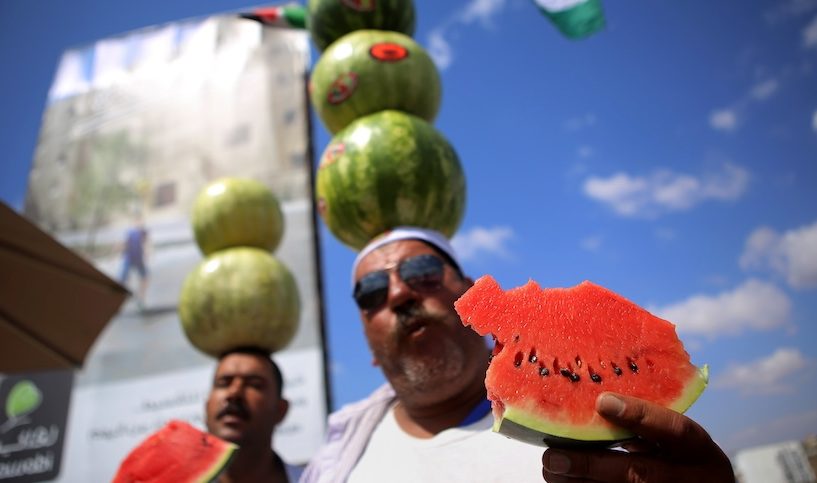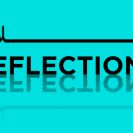Art mimics life, and the emergence of the watermelon is the most defiantly astonishing symbol of Palestinian resistance in the face of the most absurd censorship measures. It broke convention years ago, and it’s breaking algos today, as many users on Instagram have reverted to using the good old raggi emoji when signaling to Palestine in comments and texts to avoid the senseless shadowbanning users are facing today.
But first, an homage to the wonderful fruit. Cultivated throughout Palestine and spanning from the fertile fields of Jenin to the sun-kissed lands of Gaza, the emblematic watermelon vibrantly evokes the colors red, green, white, and black. A poignant instrument of protest against the oppressive restrictions imposed by the settler colony state of Israel in 1967 on the display of Palestinian flags and, by extension, the assertion of Palestinian identity.
Today, the same platforms that are streaming the truth about what is happening in Palestine are warping reality. Never before has the world come together for Palestine like this, a world united against a genocide that is literally being streamed on our social feeds, but mainstream media still dares to equate resistance with terrorism, changing truth after truth. Shadow bans on Meta are on trend, and when we resorted to X (previously Twitter) for freedom, we are seeing the same manipulation of information happen there. Tiktok? Well, may the algorithm be in your favor. We’ve been honed to blame them, the powers that be, but let’s get back to the watermelon, and why it is popping up on our feeds like a shining beacon of hope.
Once a peaceful symbol of resistance for Palestinians, we now see the mighty fruit make various appearances online. We’re working overtime to hone our linguistic skills on Meta to avoid our comments being removed and accounts deactivated, so we use the watermelon. Even before this October, Palestinians have long resorted to the watermelon emoji to circumvent the occupiers’ digital surveillance of their communications.
Celebrities are donning watermelons on t-shirts, and social posts bearing the fruit are going viral. The watermelon adorns signs in the mass protests taking place across the world, but let’s be real. We can honestly thank Gazans for waking the world up to 75 years of oppression and displacement, not the watermelon.
Nonetheless, here’s how it all allegedly started. The occupying settler colonial entity of Israel cracked down on any display of Palestinian identity and resistance from 1967 until the ban was lifted in 1993 with the Oslo Accords (which is being blatantly ignored to this very moment). Artists were condemned for the merest display of identity, and the watermelon was the ultimate forbidden fruit. Speaking to The National in an article published in 2021, artist Sliman Mansour depicted how the occupying entity shut down an exhibition at Ramallah’s 79 Gallery, which featured his work alongside artists Nabil Anani and Issam Badr. Their works were too political, and when asking the arresting officers what would happen if they had painted a flower in red, green, black, and white? The reply they received was succinct “It would be confiscated. Even if you paint a watermelon, it will be confiscated.” No actual watermelons were painted here, but an idea was born.
Fast-forward to the onset of the Oslo Accords, a New York Times article in 1993 mentions the presence of the powerful watermelon in Gaza, and how young men who carried slices of red, black, and green fruit were arrested.
Amongst its various appearances, the watermelon makes a vivid presentation in Khaled Hourani’s design, The Story of the Watermelon for the Subjective Atlas of Palestine project in 2007, commemorating the alternate flag to ask the question we still ask ourselves today: When will this occupation end?
Last August, the Arab community group Zazim spearheaded a campaign in Tel Aviv to signal the pointless arrests of individuals showing support to the Palestinian flag, where 16 taxis were designated with stickers of watermelons bearing the message “This is not a Palestinian Flag”.
The mighty watermelon has previously received some flack too. There is a concern that if its constant use as a symbolic gesture alone dominated the resistance narrative, then it should be taking away from the real issues faced by Palestinians on the ground. Agree, or disagree, we can surely state that it’s not just the watermelon that represents resistance. For a culture that’s been enduring an ethnic cleansing since 1948, when the colonizers deprived Palestinians of growing produce on their own lands, food has always stood as a symbol of unceasing resistance. Across decades, Palestinians have celebrated zaatar, oranges, olive oil, watermelons and so much more. And while the zionists of today gleefully regale in their appropriation of Palestinian culture, let alone committing war crimes, we will proudly support the watermelon.
Sources:
hyperallergic.com/666111/how-watermelon-became-a-symbol-of-palestinian-resistance
thenationalnews.com/arts/how-the-watermelon-became-a-symbol-of-palestinian-resistance-1.1230806









